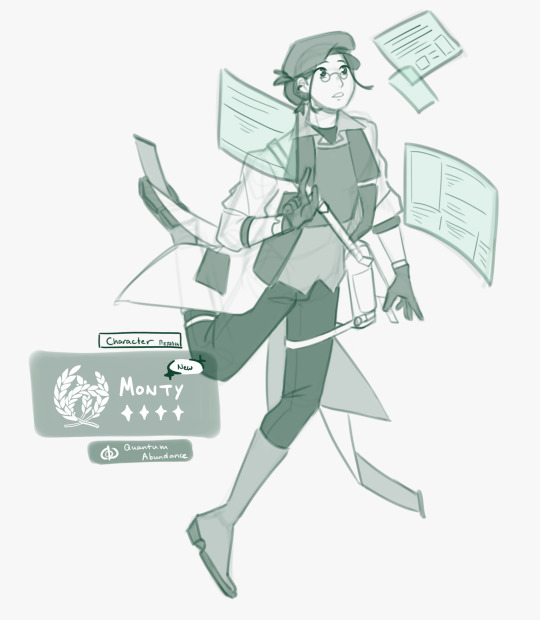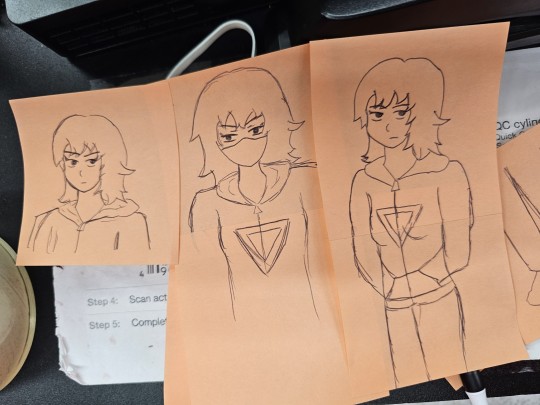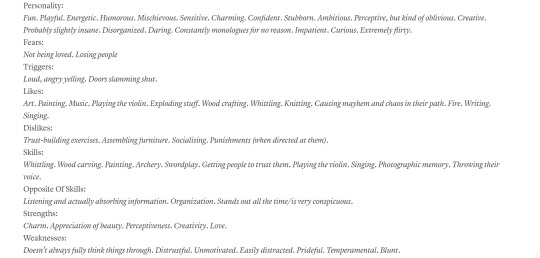#riverin oc
Text


↕️ "Hm? Looks like we have some misplaced relics again. Better put it back before we lose track of it…"
💎 "Have you seen this woman? I'm looking for her. She… owes me something."
- monty / amani [here]
- huang / nia
↕️ MONTY DARLING
A young archivist who works at Herta Space Station. Monty spends most his time organizing documents and items alike with the help of a gravity-manipulation Curio. Soft-hearted and supportive, he dreams of traveling the cosmos and befriending those who cross his path.
Monty's mentor referred him to the space station for his current position on account of his stellar academic track record. Lately, despite his best attempts, said beloved mentor has been rather difficult to contact...
💎 AMANI CHEY
A wandering shapeshifter relentlessly pursuing a figure from her past. Cold-hearted and wary, Amani has a habit of quieting rooms full of people through sheer presence alone. She is a capable fighter, conjuring various weapons of ice to meet her needs.
Her alternate form is that of a red-eyed chinchilla. Nimble and discreet, Amani likes gathering information about her target in this shape. Despite others' recommendations, she doesn't like using her chinchilla charm to disarm others with displays of cuteness.
hello to everyone !! i have some sketches of my ocs for their honkai star rail au, in a mostly splash-art-pose-with-label kind of presentation. i started this on a whim, but suddenly it snowballed into two ocs already (that's half of my main little group)! we have monty and amani here with their aforementioned little blurbs.
both of these characters are ocs i translated from their previous setting into the world of hsr, and i'm really happy with their core concepts! i also pair them together a lot because they have a lot of contrasts between each other that i enjoy seeing side by side.
i struggled with monty's design a lot in the past because he had a very classical-fantasy outfit from his original setting that i couldn't really translate over. it took a few attempts for me to give him a vague coat-ish outer layer with long-trailing tassels (to generally match asta). i think his cute little hat helped pull everything together!!
amani's outfit came a lot more easily (though you can only see the back view here). i've always enjoyed giving her the high-waisted shorts (NOT vacuum-sealed to her body), thigh-high boots, and a cropped jacket. her boot designs also ended up being really fun, with the slight cutout behind her legs for more shape-y-ness.
i have 2 more characters i hope to draw alongside monty and amani, so will see if i can get to them and have them all together as a little group !!
#monty darling#amani chey#riverin oc#riverin art#honkai star rail oc#hsr oc#honkai star rail#hsr#please perceive my beblorbeds i spent so much time the past few months brainrotting about them#i think even if i've had a really bad art year (from my pov) it's still really nice knowing i have some ocs to fall back on#also: do NOT ship these two romantically !! amani is my local aroace queen and monty always loves having friends
22 notes
·
View notes
Text
Hey, I'm making a webcomic. It's called Riverine, about a trans girl who gets superpowers. It's something that's been bouncing around in my head for a couple years now and I'm really excited to be finally making it.
I'm hoping to update it twice a week from here on out. I'd love if you give a shot!
#transgender#trans#trans girl#webcomic#webtoon#riverine#riverine comic#superhero oc#superhero comic#trans hero
11 notes
·
View notes
Text



Today was a big art/writer's block and I got basically no work done so. Woo hoo.
So here's some random unfinished stuff I've done the last couple weeks.
2 notes
·
View notes
Photo

oh yeah we were talking about it earlier but did you guys know just how insane my character connections are? It’s a fucking web.
#oc stuff#i keep feeling like Rutile and Mitile need new names#the Jadena crew isn't even accurate by name anymore#yeah Markul and the kids are in Jadena#but it's a different Jadena!#that group name is based on my 2017 writing!!!!#Riverin group at least is referring to the current writing#mostly because only Rowan and Aelin were around for the 2017 version#anyways this is a mess
4 notes
·
View notes
Text


Happy Hanukkah! Ft. Zeom and @riverin-stories' ocs, Monty and Amani!!! <3
#oc#ocs#original characters#original art#original character#demon oc#🔪#scritch#just like zeom fr... we ALSO have challah in the oven rn..... i hope it's as good as hirs...#oc zeom
4 notes
·
View notes
Note
Could you please tell me about your OCs? 👀
bestie i have so fucking many so im just going to talk about my favorites because i like them. (warning theyre all going to be from the same book)
also just, for all my ocs that are types of fae, they dont age after they settle (into their immortality as in) which is usually around 21 (in my books at least who the fuck knows when it actually happens). obvi the humans age.
myth (they/them)
this is one of my beloved self-projections (the others are aura nocturne and nyx thorne). i love them dearly.
myth's full name is myth tempest ciar. their aliases are the shadow of xaenje and the grimm. they are also known as the queen of the moors or the queen of aeqili (the old language's name for the moors) and the protector of the moors. they are 48 years old and 4' (121cm). they are gay (big surprise).
myth is part celestial nymph and part dark elf, and is the descendant of a goddess and the descendant of a demon. their magic is ice, wind, snow, lightning (from the goddess) and darkness (courtesy of the demon). they have moon-white skin (like, as light as you can fucking get), curly black hair that goes to halfway down their thighs, with extremely dark red highlights (kinda like wine-red). they have black eyes, with a core of silver and flecks of garnet.
because of them being a descendant of a demon, they can switch into a demon form -- though this is barely a change in their appearance, because of how far down the bloodline the relation is. their demon form only gives them horns and and replaces their fingernails with stone claws, and gives them the ability to use fire magic as well as their others.
they always wear dark garnet/wine-red matte lipstick/stain, and winged eyeliner with kohl lining their under-eye and waterline. they only wear silver or black jewellery, and wear only black, sometimes with hints of dark red. they also only ever wear long-sleeves, tall heels and lace gloves (they always wear them, except when fighting (they switch to leather then)). they also wear a crown almost always; either a flower crown of black rosemary (it exists in their world), blood red rose spray and black baby's breath; a silver metal flower crown, or; a crown of thorns. they always carry an ebony staff with a phoenix carved into it, and dark garnet embedded in it (this is mostly because their left leg's muscle was ripped as a child in the explosion and never healed properly so now they're technically crippled).
myth has severe ptsd, adhd, autism, severe depression (which they have named archeron), anxiety, social anxiety, dyslexia, dysgraphia, dyscalculia, insomnia and sleep paralysis.
screenshotting the next bit because typing it will be difficult:

their favorite places are libraries at night, forests at night, caves at night, villages at night, mountains at night, and graveyards at night.
when myth was eight, there was an explosion that completely changed the immortal realm created by the mortals in an attempt to steal magic. during this explosion the majority of myth's friends and family were killed -- their friends who lived in the riverine completely lost tjeir memories.
in this explosion, the frost divide was created separating the moors and the riverine. the divide is seemingly a void made of darkness, and the temperatures in it are as cold as the demon realm (which is like, really fucking cold). because this matched myth's powers, they were blamed for the frost divide's existence by the people of the riverine (who were convinced of this by the mortals). myth generally tends to just accept it because it creates fear around them and because nobody really believes them when they say anything against it.
myth at one point also dated the king of the riverine at the time of the story, however, he ended up breaking up with them when they (accidentally!!) exploded the isle of travel off of the mainland, and consequently creating the dead sea because he thought that they were too consumed with vengeance and didn't care about anything else, and also he was told that myth was the one who created the frost divide (which he previously didnt know).
myth is from my so far unwritten (but the planning is going amazingly) wip, the light in darkness (tld). :]
oblivion (he/him)
okay so oblivion's full name is oblivion, demons usually don't have last names. oh btw oblivion is a demon. he is the demon captain of the guard and is 8413 years old. he is 5'11" (180cm). he is omnisexual. his magic is darkness and fire.
honestly i havent worked on his character much, but i love him dearly. oblivion is one of myth's closest friends. screenshotting how they met because its easier and honestly my fingers are starting to hurt.

anyways oblivions just a really cool guy. i love him dearly. i havent really written about his personality much yet, but he's mostly going to be pretty quiet and reserved, so he gets along well with aeron (who barely anybody gets along with).
yeah hes cool i love him.
aquarii (they/them)
aquarii is amazing i love them. they are fairly similar to myth in alot of ways and they get along great. they, together, are a chaotic disaster who cause immense stress for most everyone else but thats okay we love that.
also aquarii is just very gender /pos.
they are a water nymph and are 69 years old (for obvious reasond it goes with the personality). they are 4'4" (134 cm). they are the captain of the guard in the riverine. they are pansexual. they have water magic.
aquarii has light porcelain skin. they have short, wavy, light electric blue hair that is always strategically messy (it makes sense i promise its like, the hot kind of messy yknow, idk how to describe it, but its the attractive messy rather than the messy my hair does which it looks like ive been running through the forest away from a monster while it was raining for the past three weeks yknow what i mean?). they have bright electric blue eyes, with a core of navy blue and flecks of gold. they have cherry pink lips and light freckles on their nose and cheeks.
they only ever wear gold jewellery, and flower crowns of white and blue forget-me-nots. they only ever wear white, blue, teal and cyan clothes that are somewhat fitted, usually with lowish, loose necklines. they always carry a gold sword with sapphires embedded in its hilt.
they have ptsd and anxiety.
screenshotting the next bit:

their favorite places are lakesides, forests, rivers, and beaches at nightnite/evening.
also screenshotting the last bit:

#bestie i am so sorry#i do not know how to shut up#also the hair thing for aquarii is very specific#i dont know how to explain it#its just#attractive messy yknow#idk#anyways#againtodreaming asks#faerambles#faewrites#faeannoyseveryonebecausetheywannatalkabouttheirocs#anyways all of them are from the light in darkness#or tld#myth ciar#myth#myth tempest ciar#oblivion#aquarii metallica#aquarii#tld#the light in darkness#my wip#wip#writing wip#oc#ocs#oc tag#oc writing#original character
3 notes
·
View notes
Note
10, 22, 49! <3
10. Introduce an OC with a complicated design?
Hm, log dude. Two forms, the riverine "parr" form based of of... parr salmon, and the sleek "depth" form based off of adult salmon in spirit. That, and orcas and sea lions, which love salmon. And the cedar trees, which receive oceanic nutrients each spawning season. The cedar head itself is based off of submerged trees (unknown if they're cedars but they're locally common so why not) in Clear Lake! it's been such a kind area to me and this lil dude is just my "ode to the Cascades" haha
22. Is there any OC of yours people tend to mischaracterize? If yes, how?
I... can't really tell! To be honest I'd be more surprised hearing that folks characterize them! I don't think I share enough information about them that it makes it that big a deal anywho
49. Which one of your OCs would most likely enjoy memes
Sparrow would but like.. minion memes and crispy jpegs of fake funny text conversations LOL
2 notes
·
View notes
Text
Air Pollution and Policy in Shanghai
On April 11th, my mother sent me a photo of the sandstorm hit in Yanzhou, Shandong, China, as she was on her business trip. The photo reminded me of the days 10 years ago in Shanghai, my hometown. Back in 2013, the light rail station three kilometers away from my home was often covered in haze on regular days. Stringent multiregional air pollution control strategies have been implemented in the recent decade in Shanghai. According to the data from Statista, the annual average PM2.5 air pollution levels in Shanghai have decreased from 59.86 ug/m3 air in 2013 to 26.52 ug/m3 air in 2022. Despite huge improvement, air pollution still remains a huge problem in Shanghai, as annual average PM2.5 pollution levels of 26.52 μg/m3 air is still much higher than the standard of 5 μg/m3 established by WHO. Nonetheless, the policy implemented so far in Shanghai has been proved effective.

Figure 1. The sandstorm in Yanzhou, Shandong, China (filmed by my mother)
Shanghai is a typical representative of developed coastal cities that heavily relies on import and export trade. Ship emissions could contribute 10 to 30% of PM2.5 within 10 km of the coastal and riverine port area. The seaside wind in summer monsoon season carries the pollution further into the central area in Shanghai. To address the issue, Shanghai has adopted the Emission Control Area (ECA) policy to reduce ambient SO2 and particle components. Strict ship diesel emissions standards are included in the ECAs. Ships in ECAs are required to replace high sulfur oil with light oil that contains sulfur content less than or equal to 0.5%. The ECAs have been proven effective. The SO2 concentration in Shanghai decreased by at least 0.229 μg/m3 daily on average due to the ECA policy implementation. From 2015 to 2017, the average 3-month SO2 concentrations decreased by 27% to 55% in both port sites and urban sites in Shanghai, with the highest decrease of 55% in Gaoqiao site (port site), which is influenced by heavy ship traffic activity.

Figure 2. Yangshan port, Shanghai (Image Link: https://www.shine.cn/biz/economy/2111218489/)
However, there are downsides of ECAs. First, although SO2 and PM2.5 emissions decreased effectively in ECAs, NOx emissions that primarily depends on engine temperature and combustion cycle did not. In addition, OC components in ship-emitted particles increased as some organics like toluene from low sulfur heavy fuel oil were much higher than those from high sulfur heavy fuel oil.
The ECAs are still being implemented today, with time, ships will use light oil that has sulfur content below 0.1%. Meanwhile, Shanghai has implemented policy in other aspects and keeps introducing new policy for air pollution control. For example, Shanghai has been expanding clean energy vehicles and all-electric bus. Nowadays, there are much more vehicles with green license plates (electric or hybrid power) than vehicles with blue license plates (traditional fuel). Temporary shut down and penalties for polluting factories have also contributed to air pollution control. Someday, we might breathe the fresh air that meet the WHO standards in large cities like Shanghai.
References:
Liu, Q., Liu, X., Liu, T., Kang, Y., Chen, Y., Li, J., & Zhang, H. (2020). Seasonal variation in particle contribution and aerosol types in shanghai based on satellite data from modis and caliop. Particuology, 51, 18-25.
Wu, R., Dai, H., Geng, Y., Xie, Y., Masui, T., Liu, Z., & Qian, Y. (2017). Economic impacts from PM2. 5 pollution-related health effects: a case study in Shanghai. Environmental science & technology, 51(9), 5035-5042.
Zhang, Q., Zheng, Z., Wan, Z., & Zheng, S. (2020). Does emission control area policy reduce sulfur dioxides concentration in Shanghai?. Transportation Research Part D: Transport and Environment, 81, 102289.
Zhang, X., Zhang, Y., Liu, Y., Zhao, J., Zhou, Y., Wang, X., ... & Chen, J. (2019). Changes in the SO2 level and PM2. 5 components in Shanghai driven by implementing the ship emission control policy. Environmental science & technology, 53(19), 11580-11587.
1 note
·
View note
Photo






#j posts things#mine#my art#c: thane#c: emilie#c: devon#c: kale#c: darla#c: damien#thane the spotted hyena#emilie the riverine rabbit#devon the zebra#kale the serval#darla the crocodile#damien the crocodile#ocs#original characters#fnaf#fnaf ocs#fnaf oc#five nights at freddy's#matthew's wildlife adventure#my au
8 notes
·
View notes
Note
BTV OC question time. 11.If your character could choose to live anywhere, where would they live? 25.What would make your character lose their trust in someone?
thank you for the ask! gotta go through the list and do this for everyone <3
11. Imladris loves her hometown, Wycombe. I’ve been imagining now the old Lavellan city is like the underground city Kaymakli, in Turkey, because they’d be looking for a place easy to defend, easy to hide, and connect to the surface settlement of House Cadash, with a more obvious riverine settlement (like Venice, but in wood--they don’t have the money quite yet to show off like Venice) that’s set up for trade. The city that leads into the cliffs is connected by a series of passageways into the alienage, and she misses having the total certainty of an extremely confusing hometown. been chewing over how exactly that would all be geothermically possible--I know the city’s carved into tufa, and isn’t Kirkwall built on a caldera? so I can say that’s all volcanic rock, but I really really want a lagoon too.
25. Selling her out to Orlais, doing anything that could leave her and her allies more vulnerable to the machinations of the more established powers of Thedas.
3 notes
·
View notes
Note
Your head canons on Valyria are so interesting. I like the connections to our world cultures. I'm wondering if you have similar ones for other cultures of the books series? It would be great to know your thoughts.
[ Hello there, and thank you so much for sending this in,it’s always nice to know there are those who like your things! Andsorry for taking a while to get to this.
First, as I always like to add before starting anything related tomy headcanons on ASOIAF things, let’s remember that this is a fantasyworld with its own rules apart from ours. There are many things thatwon’t make sense if we try to explain them with what is known in ourreality, as GRRM himself has stated to those who try to do so.
That being said, there are things that have obviously beeninspired on real life history but not necessarily based on them. I’dsay Valyria ( and the Free Cities founded by it ) is one of the moreobvious things ( some of the reasons which I’ve explained in theheadcanons ) but there are other cultures and civilizations that I’dsay are just a mix of different real world ones.
The Rhoynar for example, I’d say were inspired from the riverinecultures like ancient Egypt and Mesopotamia, particularly Mesopotamia( often I’ve seen them inspired by Greece because of the wholecity-states concept but this was actually a thing in Mesopotamia aswell and along with the river dwelling peoples thing, I think makesmore sense than Greece but doesn’t mean there’s no greek influencethere at all either ).
The Dothraki are pretty evidently inspired by the Mongols andother peoples with the nomadic, ‘horse riding all their lives’cultures.
Asshai I think is reminiscent of a Persian influence maybe in itsreligion ( which I need to look more into but if I remember right, itworships fire as something sacred ).
Sothoryos is pretty much the Africa of ASOIAF, I think but not necessarily be a blatant copy because along with Ulthos, we havepretty much nothing about those continents.
Old Ghis I’d say have Phoenician influences, down to the wars withValyria being inspired by the Punic Wars of Rome and Carthage.
YiTi is pretty Eastern Asian in influence, be it in the people andculture.
Westeros I’d say is pretty much western Europe with celtic,british, french and germanic influences, as well as some spaniard andportuguese influences in Dorne.
But having said all this, again, I say influence instead of 'basedon’ because I think it’s important to remember that ASOIAF is afictional, fantasy world and as such, I don’t think we can actuallyapply or try to give it a real life logic to it. I think it takesaway from the story when we try to compare it to real lifedescriptions because it’s just a fantasy work that would maybe bebest left to its own comparisons. I know it’s an unpopular opinion orway of thinking, but this is also why when it comes to choosing faceclaims, ethnicities of said face claims have very little influence tome rather than the appearance itself of the face claim.
I can only speak for my valyrian muses, but for example, myRhaegar face claim is brazilian, my dragonlord OC’s face claim isnorth american, and my Aegon face claims are british, polish andturkish ( which in themselves are a mix of other ethnicities toopretty much ). And I decided on them based on their appearance, noton their ethnicity; simply because ASOIAF races and ethnicities do notexist in real life ( because they are made up, so I don’t think itapplies to say 'this character is a poc or this character is white’ though of course they all may represent–different from based–said terms ). I know, it’s a pretty unpopular thing but… I’ve always done myown thing so won’t start changing that now.
Of course, it’s withoutsaying that it doesn’t mean I think others who go by this are wrongbecause not at all, I think we all have a right to our own takes onour characters, and that includes their appearance too. Diversityinspires creativity and that only makes RPing all the more fun! Butagain, I want to remark that this is just my own opinion, in no waydo I think it’s the right one and that others are wrong, that hasnever been how I go.
And I think this hopefully answers your question, and again, sosorry for taking a while. Thanks for sending this in! ]
#again thanks for sending yes!#it's just how i see them but i know others see it differently and that's totally fine xp#but thank you so much for liking my valyria things yes! it really means a lot!#ooc#anonymous#[ Knowledge B U R D E N S but ignorance K I L L S ] asks
7 notes
·
View notes
Text







regarding absence.
some personal musings around not having appropriate terminology to articulate some of my experiences growing up, and wishing that i had someone to talk to me about these things in hindsight. over the years, i ended up learning a lot more about myself and aromanticism through one of my oldest ocs to date, miyaka, who ended up being aro-spec herself!
i think it's a very precious experience to have a long-term oc grow with me, and be a reflection of how i explored my own identity. and of course, i'm always growing and learning, and it makes me excited to see how that may crop up not just in miyaka, but across all my ocs, art, and writing too!
this was drawn very casually and unpolished for aromantic spectrum awareness week. i know i'm at the tail-end of it / could even be late, but i definitely decided i want to draw something for it this year. i also had more scenes / depictions floating around in my head while working on this, but ended up excluding some things because i was running out of energy (and time). i was also challenging myself with making this a mainly-textless comic save for the end, so a lot of brainpower went into that and left me tired. >.>'
if you made it this far, thank you very much for reading, and i hope you have a lovely day! :D
#miyaka fujiwara#riverin art#riverin oc#aromantic#aromantic spectrum#aro#arospec#aromantic awareness week#arospec awareness week#aromantic spectrum awareness week#whoagh thats a lotta tags#i hope that if anyone sees this and resonates in any way with it... know that i am extending a lot of warmth and love to you!!#aro friends are deserving of the world and i hope the past week has treated you well#and if not i hope good tidings are right around the corner for you!
6 notes
·
View notes
Text

Cover image for my webcomic. Probably. Assuming I don't hate it tomorrow and end up redoing it.
Gonna be starting it soon~
8 notes
·
View notes
Text

drawing rain is hard.
drawing is hard.
drawing hard.
hard.
6 notes
·
View notes
Text
Juniper Publishers- Open Access Journal of Environmental Sciences & Natural Resources

The Impact of Tropical Cyclone 'Phailin' on the Hydrology of Chilika Lagoon, India
Authored by Pradipta R Muduli
Abstract
The Asia’s largest lagoon; Chilika, designated as first Ramsar site in India, was studied after a severe cyclonic storm “Phailin” in October 2013 that was coupled with heavy precipitation and flooding. Physicochemical parameters, nutrients, and salinity data were analyzed to understand the impact of Phailin on the hydrology of lagoon. Multidimensional scaling analysis of 15 years of salinity data, revealed spatial partitioning of lagoon into four distinct ecological sectors; southern, central, northern, and outer channel. Fresh water discharge from the rivers remained a dominating factor for controlling the salinity regime of the lagoon (r= -0.2894, p= 0.0144).
A significant change in the salinity regime as well as in the nutrients was observed after the cyclone compared to the pre-cyclone months. The salinity of southern, central sectors and outer channel decreased by 28.7, 29.8, and 19.1% respectively, whereas in the northern sector, it remained fairly constant compared to pre-cyclone months. There was an overall increase in silicate concentration in the lagoon after cyclone due to riverine silicate influx evidenced by a significant negative correlation between salinity and silicate concentration in the lagoon. However, there was a decline in nitrate+nitrite and phosphate concentration throughout the lagoon mostly due to dilution effect as well as adsorption to sediment in case of phosphate. The impact of cyclone was also distinctly visible on specific biota such as sea grasses, macrophytes, and benthic community which are considered as good bio-indicators.
Keywords : Chilika; Lagoon; Nutrient dilution; Phailin; River discharge; Ramsar Site; Super cyclone; Water quality
Introduction
The Bay of Bengal region of the Indian subcontinent is well known for origin of tropical cyclones, which often turn into super cyclone before hitting the continental land mass. Most tropical regions are exposed to high intensity rainfalls associated with cyclones Summer et al. [1]. Two of the cyclonic storms had hit the east coast state of India; Odisha during October of year 1999 (super cyclone) and in 2013 (severe cyclonic storm). A very severe cyclonic storm Phailin had landfall to south Odisha coast on 12th October 2013 with a sustained maximum surface wind speed of 200-210 kmph gusting to 220 kmph (IMD Report [2]. An ecological effect of such major storms on coastal ecosystems has been studied by many researchers Bhatacharya et al. [3]; Mitra et al. [4]; Reddy et al. [5]; Satpathy et al. [6]; Webster et al. [7]. Freshwater discharge can play an important role in changing the water chemistry and hydrology of the coastal estuarine ecosystem Kanuri et al. [8]; Muduli et al., 2012 [9], Muduli et al., 2013 [10], Worldwide many studies are focused on the influence of heavy freshwater discharge (due to flood events) on water quality of coastal ecosystems; Martinez-Mena et al. [11]; Steven [12]. However, such studies in context to Indian lagoon ecosystems are lacking.
Salinity is an important factor in determining the distribution of biodiversity of flora and fauna in coastal ecosystem Benjamin et al. [13]; Mcevoy et al. [14]. For instance, benthic organisms and sea grass communities have been shown to be significantly influenced by the change in salinity and turbid water flux which occurs during flood events Gaonkar et al. [15]; Orth et al. [16]. Flux of nutrients during flooding can alter the rate of primary production in the aftermath of cyclone Murrell et al. [17]; Sarma et al. [18]. Thus, monitoring of water quality assumes high priority to understand the impact of cyclone on the hydrology and biodiversity of the lagoon.
Chilika lagoon is a highly sensitive and complex ecosystem especially due to large catchment size (3500 Km2). A variety of land-derived discharge flows into the lagoon through several rivers and their distributaries. The flood after the cyclone Phailin brought a huge amount of freshwater of different chemistry into the lagoon, which could have an adverse effect on the hydrology and water quality. As salinity and nutrients are vital parameters influencing and determining the ecology and biodiversity in coastal lagoon, these two parameters were studied in great details in relation to Phailin. The specific objectives of this study are to understand
i. The effect of Phailin on the nutrients inputs from major rivers that drain into Chilika lagoon and the influence of this input on the water quality of different sectors of the lagoon.
ii. The impact of Phailin on the salinity regime of the lagoon.
Materials and Methods
Study Area
Chilika lagoon (Figure 1) is a largest brackish water lagoon in Asia located on the east coast of India (19 28' 19 54' N and 85 06' 85 35' E). It is one of the most dynamic shallow ecosystems (average depth: 2m), about 65 km long and spreading parallel to the coastline in north east to south west direction with a varying width (reaching to average 20 km). There are 52 rivers and rivulets that drain fresh water and sediment into the lagoon. There are three inlets (showed as one in the figure, due to very small spatial distances ~300m) connected to sea through which saline water enters into the lagoon. Apart from this, lagoon through the Palur Canal (Figure 1) at the southern part of the lagoon connected to the sea, through Rushikulya estuary.
Sampling and Analysis
Sampling was carried out during September and October months of year 2013 from 30 different stations covering all four sectors: Southern (SS), Central (CS), Northern (NS) and outer channel (OC) (Figure 1). Simultaneously, samples were also collected from 11 major rivers streams that drain into Chilika lagoon. Surface water samples were collected using a 5L Niskin bottle. Nutrients [nitrate+nitrite (NO3+NO2), phosphate (PO4), and silicate (SiO2)] were estimated by nutrient auto analyser (SKALAR SANplus ANALYZER) following SKALAR methodology with the precisions of nitrate+nitrite ±0.02, 0.01, and 0.02 |imol, respectively. Temperature and pH and salinity were measured using water quality Checker (TOA DKK, WQC24). Chlorophyll-a, dissolved oxygen and turbidity data were recorded using optical sensor in the sondes of data buoys (Multi-parameter water quality sonde; 6 Series; DATA BUOY; YSI, USA) deployed at each sector set to provide real-time water quality data at 15-minute intervals. Data of 30 days before and after Phailin were considered for correlation analysis.
Qualitative and quantitative assessment of the benthic community was made by adopting stringent methods described earlier Gosner et al. [19]; Holme et al. [20]. Sea grasses and freshwater macrophyte survey was carried out after three months of the cyclone, and identifications were made using taxonomic keys described earlier Campbell et al. [21]; Kanan et al. [22]. Using float method, long-term river discharge data was recorded everyday between years 2004-2013. Average discharge data of each month was considered for calculation of nutrient flux (discharge x nutrient concentration), as samples for nutrient analyses were collected only twice a month and average values were used for all calculations.
Result and Discussion
Phailin caused a drastic change in salinity gradient and nutrients status of Chilika lagoon. The extent of which varied depended on the flow rate and concentration of nutrients in the riverine inputs.
Physico-chemical parameters
Transparency of the entire lagoon decreased by 31% except SS of the lagoon where it remained almost same due to least freshwater inflow to this sector. The transparency decreased 1.35, 1.50 and 1.41 times in CS, NS, and OC, respectively. However, such significant change between the months (September and October) was not observed during 2012 (Tables 1a &1b). This could be attributed to the inflow of turbid water from rivers as well as mixing of bottom sediment due to wind-induced wave action caused by Phailin. Since the turbid water, inflow was highest in NS (Tables 1a & 1b) (Figure 2), this sector also experienced the lowest transparency Nixon et al. [23]. The pH in SS and CS was observed to increase significantly (Figure 2), which could be due to dominating primary production though there was a decrease, in transparency (Table 1b).
The production might have contributed by re-suspended benthic algae, which have better production than the pelagic algae Annual report [24]. This phenomenon was also evidenced with concurrent increase in chlorophyll-a and dissolved oxygen. Overall pH of the lagoon remained almost same however there was a significant decrease in DO concentration observed, could be attributed to surfing of lagoon water. This observation is unlike to that observed in other ecosystem affected by cyclonic events Bhatacharya et al. [3]; Mitra et al. [4]. Before Phailin, the Chlorophyll-a concentration was 3.2 μg L-1 which increased to 4.1 μg L-1 after Phailin. chlorophyll-a also showed a positive correlation with dissolved oxygen (r=0.28, p=0.0001) indicating that increase in oxygen was due to primary production rather than by surfing of water due to heavy winds Hull et al. [25]. A strong positive correlation (r=0.71, p=0.0001) between chlorophyll-a concentration and turbidity further supported the fact that suspended particulates mostly contained Chlorophyll-a during the study period.
Salinity Variation in Chilika during the Monsoon
The salinity of the Chilika lagoon is predominantly controlled by the sea water exchange and river water discharge. Apart from these, Palur canal, which is connected to the sea through Rushikulya estuary, also raises salinity of the lagoon (Figure 1). Depending upon the freshwater influx of rivers, the salinity regimes were significantly different in each sector, which was evident from the multi-dimensional scale (MDS) plot (Figure 3). River discharge during the high-flow period was compared with average salinity ofthe whole lagoon recorded between years 2004 to 2013. There was a significant influence of river discharge on water quality of Chilika as evident from the regression analysis (r=0.2894, p=0.0144) (Figure 4). It was found that during the high river discharge period in years 2006, 2008 and 2013, the average salinity of the lagoon decreased, considerably.
The salinity recorded in monsoon (July to October) was examined and compared with recent observation from different sectors (Figure 5). Since 1999, during monsoon, the salinity of the lagoon varied between 4.6 to 11.9 with an average of 8.3, whereas during the non-monsoon period the salinity varied between 9.1 to 15 with an average of 12.7. The lowest salinity value observed during 2006 could be attributed to flood events that brought heavy freshwater discharge (Figure 3). Higher salinity of >11 during 2002, 2004 and 2005 could be due to late arrival of monsoon. The lowest salinity during 1999 was the indication of poor exchange of sea water with lagoon, which led to an opening of a new mouth during September 2000 Jayaraman et al. [26].
Spatial variation in salinity due to Phailin
The results of the present study revealed that during October 2013, the average salinity of the entire lagoon reached to a level of 1.72, which was the lowest ever recorded since 1999 for October month. After Phailin, the salinity of the lagoon decreased by 3.3 times and 4.8 times as compared to previous month i.e. September 2013 and previous year October 2012, respectively. Comparison of salinity of October 2013 with September 2013 indicated that the salinity of the NS remained almost same, whereas in OC maximum decrease in the salinity was observed. The decrease in salinity of SS, CS and OC was observed to be 7.1, 2.3, and 8 times respectively ((Figure 2)) (Table 1b). The decline in salinity was not only due to the freshwater riverine discharge but also from the massive rainfall after Phailin. The level of salinity decreased in October 2013 in following order: OC>SS> CS> NS as compared to the average values of October months of last 14 years (since 1999 to 2012) and the magnitude were 7.95, 2.47, 1.93, and 1.29 times, respectively. Since last 14 years, during October, average salinity in the OC, SS, CS and NS were 8, 8.8, 2.4, and 1.4 respectively. However, after Phailin, average salinity in the in the OC, SS, CS and NS decreased to 1.02, 3.56, 1.24, and 1.08, respectively. After Phailin, the salinity in SS and OC was found to be the lowest ever recorded in last 15 years, though there was a natural opening of a new mouth during the Phailin (Forest beat house) about 1 km northward to an earlier existing mouth at Gabakunda. The resultant all time low salinity in the lagoon could be attributed to unidirectional freshwater flow (from lagoon to sea) at the mouth.
Effect of Nutrient Flux from Major Rivers
There was a significant decrease in river nutrient concentration (except silicate) which caused dilution of nutrient concentrations in the lagoon (Table 1b) (Figure 2). A number of studies have reported high variability in the concentrations of these nutrients due to freshwater discharge Acharya et at. [27]; Bond et at. [28]; Sarma et at. [29]. After the Phailin, PO4 concentration in the lagoon showed 2.9 times decrease whereas silicate concentration increased by 2.94 times; being highest in NS and lowest in CS. There was a decrease in nitrate concentration (Table 1) observed after could be due to dilution effect however the increase in nitrate concentration has been reported for other ecosystems such as, Kannada coast Reddy et at. [5], Kalpakam Satpathy et at. [30], southwest coast of India and Sunder ban mangrove wetland ( Bhattacharya et at. [3]. In contrast, few studies have also reported no significant changes in the concentration of dissolved P with change in environmental conditions Meyer et at. [31]. However, the total fluxes of all nutrients were found to be increased 3.8 fold due to Phailin induced heavy rainfall. Total nutrient flux from the Mahanadi catchment contributed ~85% as compared to the western catchment (Table 2). During 2012, the variation in nutrient concentrations between September and October months was not significant (ANOVA, p > 0.05) but in 2013 it was found to be highly significant (ANOVA, p<0.05) indicated drastic changes in water chemistry due to cyclone.
Consequences of changes in water quality on biodiversity
Due to sudden fall in salinity decomposition and decrease of rich sea grass meadows of Halophila ovalis was observed. While, the appearance of freshwater weeds such as Chara sp. and Naja sp. in most parts of the SS could be considered as an effect of changes in salinity regime of the lagoon due to cyclone. Halophila ovalis is highly productive over a salinity range of 15 to 35 and can withstand salinity <10 up to one month Benjamin et al. [13]. Thus, the reduction in salinity after Phailin did not favour Halophila ovalis growth but promoted the proliferation of freshwater weed species. A significant variation in the macro benthic group composition and decrease in abundance were also observed after the Phailin which could be due to sudden drop in salinity and increase in turbidity in the water column Alongi et al. [32]; Murrel et al. [17] (Table 1b).
Among the macro benthic groups, benthic amphipod was found dominant in November 2013 while during the previous year, polychaetes group were dominant [33]. There were number of small juveniles of polychaetes and amphipods were noticed and their biomass was comparatively higher than the previous year (October 2012). This could be due to the presence of more molluscan species. Overall the benthic biomass and abundance was decreased from 44 to 40 gm m-2 and 365 to 241 nos. m-2 respectively after Phailin. Change in the dominant group indicated the possible influence of super cyclone Phailin on the bottom substratum of the Chilika lagoon.
Conclusion
The present study reported the immediate changes in water quality of lagoon due to Phailin such as increasing silicate concentration and dilution of PO4 and NO3+NO2. The salinity of the lagoon, remained lowest in SS and OC compared to last 15 years of record. The overall decrease in salinity and turbidity resulted in loss of sea grass meadows and proliferation of freshwater weeds as well as changes in benthic communities. The present study could be treated as baseline information for further research especially on the changes in water quality and diversity of zooplankton, phytoplankton, and benthic macro fauna after the cyclonic storm. The long-term study on these aspects will be helpful for understanding the recovery period and resilience of the coastal lagoons from such extreme weather events. This data and knowledge would be useful in modelling studies to predict the health of an ecosystem and accordingly management action could be planned to restore the ecosystem balance. As due to climate change the frequency of the extreme weather events like cyclone are likely to be exuberated.
Recommendations
Chilika lagoon, a shallow brackish water lagoon with an average depth of ~1.5 m is influenced by high seasonal fluctuation in water inflows and evaporation, changing its volume, significantly. This decides the residence time of water with nutrients influencing the biogeochemistry of the entire lagoon. High precipitation induced by severe cyclonic storm suddenly changes the water quality which ultimately has an adverse effect on the balance of an ecosystem. The change in water level is likely to affect important littoral macrophytes- lined fish spawning and nursery zones and important habitat for benthic fauna and pelagic component. Water quality of an aquatic ecosystem is a crucial indicator to understand the ecological health. The change in water quality has an immediate effect on the phytoplankton followed by zooplankton and fisheries. Hence, studies must be extended to plankton and their influence on the productivity and fishery diversity. In shallow ecosystem, during cyclonic events, heavy precipitation with river discharge also change the sediment texture and composition which might affect the benthic community structure. Thus long-term studies to understand the recovery period of the ecosystem (in terms of salinity, nutrient level, plank tonic structure, sea grass, benthic communities and fishery) is essential for the sustainable management, lake productivity, perpetual ecosystem services and biodiversity of the lagoon.
For more articles in Open Access Journal of Environmental Sciences & Natural Resources please click on: https://juniperpublishers.com/ijesnr/index.php
#More About Juniper Publishers#Atmospheric Science#Climatology'#human ecology#Pollution#Juniper Publishers Journals
0 notes
Photo

and here’s the second dtiys trade we did! this one is for @riverin-stories! we referenced this drawing she did of her oc, miyaka, who we would readily marry if given the chance
#oc#original character#(( god i never know how to tag oc art... ))#(( im so sorry miyaka my love i have no idea how to tag you- ))#(( anyway! we love her so much tysm river for asking us to do this!! ))#🔪#nice#miyaka fujiwara
8 notes
·
View notes